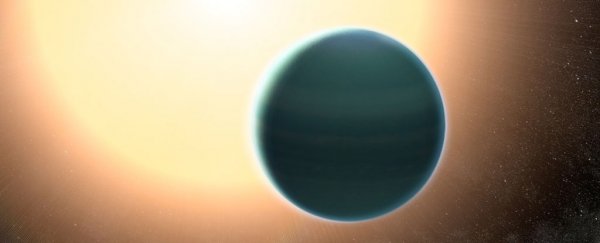Unexpected findings about the atmosphere of a distant Neptune-sized world have surprised scientists, acting as a reminder that as we discover more about planets beyond our Sun, the lessons we've learned from our own Solar System certainly don't always apply.
In this case, HAT-P-26b – located some 437 light-years away from Earth – is what's called a 'warm' or 'hot Neptune', meaning its mass is similar to Neptune, but that the planet closely orbits its host star. These kinds of worlds have been discovered before, but nothing quite like HAT-P-26b.
"Astronomers have just begun to investigate the atmospheres of these distant Neptune-mass planets, and almost right away, we found an example that goes against the trend in our Solar System," says one of the researchers, Hannah Wakeford from NASA's Goddard Space Flight Centre.
"This kind of unexpected result is why I really love exploring the atmospheres of alien planets."
What's unusual about HAT-P-26b is its unexpectedly primordial atmosphere, composed almost entirely of hydrogen and helium. For a planet that hangs so close to its star – orbiting it in just 4.23 days, in fact – that breaks a pattern astronomers are used to seeing in the atmospheric composition of other planets.
As it happens, that tight orbit is what made HAT-P-26b easy to study. One of the ways scientists can research the atmosphere of alien worlds is by observing planets as they transit (pass in front of) their host stars.
When planets do this, telescopes can analyse the starlight that gets filtered by the planet's atmosphere, which can tell us about the chemicals that make up that airspace.
Using data from NASA's Hubble and Spitzer space telescopes, Wakeford's team found that HAT-P-26b's atmosphere is largely clear of clouds but reveals a strong water signature – what the researchers say is the best measurement to date of water on an exoplanet of this size.
Crucially, that water signature enabled the team to estimate HAT-P-26b's metallicity: the extent to which the planet's atmosphere is dominated by elements heavier than hydrogen and helium.
In the case of our own Solar System, metallicities are lower for bigger planets – evidenced by the gas giants Jupiter and Saturn, with Jupiter having a metallicity up to 5 times that of the Sun, while Saturn contains about 10 times as much as the Sun.
What this means is that their atmospheres are mostly made up of hydrogen and helium. By contrast, Uranus and Neptune, which are smaller and orbit the Sun more distantly, contain greater metallicity – of around 100 times that of the Sun.
The pattern here is that, among our Solar System's outer planets at least, metallicities are lower for the bigger planets that lie closer to the Sun.
Scientists think that this is because, when these worlds formed from the protoplanetary dust that surrounded the Sun when the Solar System was young, Jupiter and Saturn were bombarded by less icy debris rich in heavy elements.
As a result, their subsequent atmospheres retain less metallicity today.
But in the case of HAT-P-26b, we've got a world that's not far out from its host star – and is in fact virtually clinging to it – and yet its atmosphere is almost entirely composed of hydrogen and helium, much like Jupiter and Saturn.
"[T]hat means that it probably formed much closer to its star, or later in the disc lifetime where it wasn't bombarded by icy debris and rich heavy elements whilst it was forming," Wakeford told Amina Khan at the Los Angeles Times, although in either case the researchers say it's a surprising result.
"We did not know that you could form these-sized planets closer to their star."
While it's definitely a quirk, it's an incredibly valuable one for astronomers, because it tells us that there are a lot more planetary possibilities than the template laid down in our own cosmic neighbourhood – and that means there's more surprising space science coming our way in the future.
"This analysis shows that there is a lot more diversity in the atmospheres of these exoplanets than we were expecting, which is providing insight into how planets can form and evolve differently than in our Solar System," one of the team, David K. Sing from the University of Exeter in the UK, explains in a press release.
"I would say that has been a theme in the studies of exoplanets: Researchers keep finding surprising diversity."
The findings are reported in Science.
